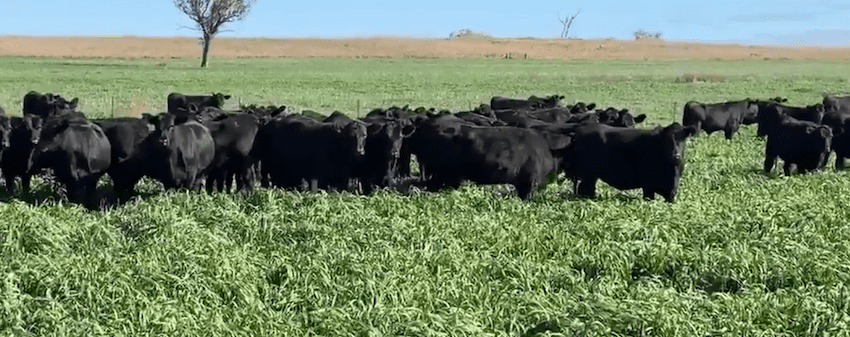A LARGE variation of winter forage is starting to show in New South Wales, with some areas able to plant early and put cattle on crops and others struggling through the first of the frosts.
Pasture crops have been a big driver of cattle movements in the past couple of years, with NSW and Southern Qld coming out of drought and large numbers coming down from the north and onto oats crops.
This year has been a bit different with a dry finish to summer seeing some producers starting to offload cattle – particularly in Southern Qld.
Ray White Tamworth livestock agent Scott Simshauser said Northern NSW was a mixed bag with oats and other pasture crops.
“There’s an area from Tamworth to Barraba that had some good rain, where most people who had an intention of planting oats or any forage have completed it,” Mr Simshauser said.
“But there is a big variation in the oats at the moment, there was almost three sowing windows. Some people had as much rain as they have ever had in March and planted early – where the oats is good, it is very good.
“Others had minimal or late rain and I think their crops are going get a bit of a check with this cold weather.”
Still optimism for this year’s crop
Mr Simshauser said there was still plenty of optimism about the late crops.
“The late crops eventually get going in most years and I don’t see this year being any different. assuming there is a rain event late May or June, you won’t see cattle on those oats until July or August,” he said.
While last year saw relentless wet weather, fertiliser prices reached record levels. Mr Simshauser said it definitely had an impact on the amount of fodder crops planted last year.
“We saw people get their cattle off early last year because the season was so good and fertilizer prices were so high,” he said.
“I don’t think there is any difference in the area planted with oats, it just looks different because it has been drier.”
More calculated management
Asked whether the latest drop in cattle prices has had an impact on decision making in the area, Mr Simshauser said a lot of other factors were being considered.
“There’s no doubt there’s an appetite for backgrounding cattle on oats, but people are very cautious about making sure they have enough feed and there is very little risk taking,” he said.
“It is very different to what it was like before the drought, people are very tuned up, they know what they want to do, they have an end target and they look to be sticking to those targets.”
“They are very professional with their pastures now as well, it’s no longer just oats, we are seeing a mix of high-performance pastures and people seem to know their potential.”
Considerably less oats Southern NSW
Roger Garnsey is a Canberra-based agronomist, who works across southern NSW, particularly in the Holbrook area. He said the area had seen considerable autumn rain, which was making it hard to plant forage crops.
“Our planting window goes through to June, but we would need some frosty weather over the next couple of weeks to harden it up and then we could plant,” Mr Garnsey said.
“But the east coast lows are hanging around and if get another one of those, I think it will be all over for the winter forages.”
Mr Garnsey with there was already a lot of feed with the rain over summer and autumn, which will likely decrease the size of the oats crop.
“For that reason, I would say there is going to be a lot less oats planted in our area this year,” he said.
Cautious interest in soil carbon
Asked whether soil carbon projects were starting to influence planting decisions, Mr Garnsey said people were interested but not acting.
“There’s too much uncertainty around it, people are interested and if there is a clearer path, in-terms of reporting, and more certainty in the market they might proceed with it,” he said
“A lot of people are already recording organic carbon, but they are not doing it through to methodology. I know handful of people who are actually doing it, but they are very much the first movers.”
Similar sentiment was made by Mr Simshauser, who said most people in the area have researched it and know about it – but are still apprehensive to start.
“There is a group who are into it and have started projects, another group who want to do something about and other people who have heard about it, but have not done any research,” he said.
“If you went to the saleyards 10-years-ago and asked about it, you would have received the same answer from everyone. Now, everyone knows about it and has a different opinion on it.
“It is another example of people being more educated and doing different things.”

